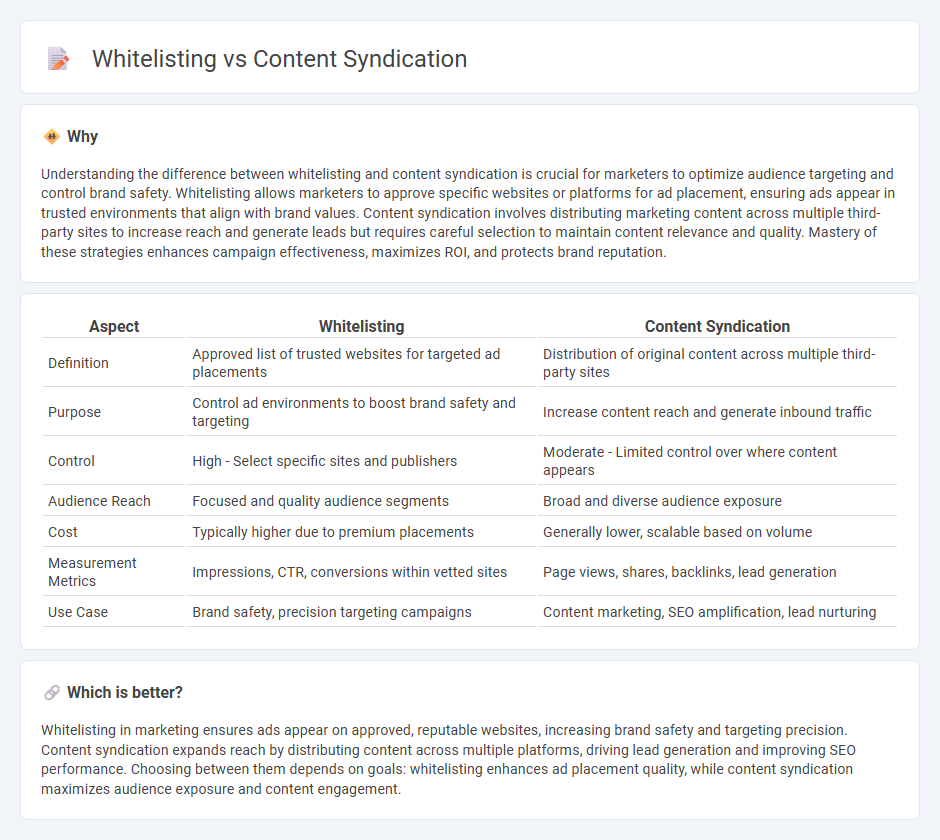
Whitelisting in marketing involves pre-approved advertising placements on trusted platforms to ensure brand safety and targeted reach, while content syndication distributes original content across multiple third-party sites to increase visibility and drive traffic. Both strategies enhance audience engagement and improve lead generation by leveraging different distribution methods. Discover how to optimize your marketing mix with whitelisting and content syndication for maximum impact.
Why it is important
Understanding the difference between whitelisting and content syndication is crucial for marketers to optimize audience targeting and control brand safety. Whitelisting allows marketers to approve specific websites or platforms for ad placement, ensuring ads appear in trusted environments that align with brand values. Content syndication involves distributing marketing content across multiple third-party sites to increase reach and generate leads but requires careful selection to maintain content relevance and quality. Mastery of these strategies enhances campaign effectiveness, maximizes ROI, and protects brand reputation.
Comparison Table
| Aspect | Whitelisting | Content Syndication |
|---|---|---|
| Definition | Approved list of trusted websites for targeted ad placements | Distribution of original content across multiple third-party sites |
| Purpose | Control ad environments to boost brand safety and targeting | Increase content reach and generate inbound traffic |
| Control | High - Select specific sites and publishers | Moderate - Limited control over where content appears |
| Audience Reach | Focused and quality audience segments | Broad and diverse audience exposure |
| Cost | Typically higher due to premium placements | Generally lower, scalable based on volume |
| Measurement Metrics | Impressions, CTR, conversions within vetted sites | Page views, shares, backlinks, lead generation |
| Use Case | Brand safety, precision targeting campaigns | Content marketing, SEO amplification, lead nurturing |
Which is better?
Whitelisting in marketing ensures ads appear on approved, reputable websites, increasing brand safety and targeting precision. Content syndication expands reach by distributing content across multiple platforms, driving lead generation and improving SEO performance. Choosing between them depends on goals: whitelisting enhances ad placement quality, while content syndication maximizes audience exposure and content engagement.
Connection
Whitelisting enhances content syndication by ensuring approved, high-quality content is distributed across trusted platforms, increasing brand safety and audience reach. Content syndication amplifies marketing efforts by republishing original content on multiple third-party websites, driving traffic back to the source and boosting SEO. When combined, whitelisting guarantees that syndicated content appears only on relevant, authoritative sites, optimizing lead generation and engagement metrics.
Key Terms
Distribution
Content syndication amplifies reach by distributing articles or media across multiple third-party platforms to attract diverse audiences and drive traffic back to the original site. Whitelisting involves pre-approved channels or domains, ensuring content appears only on trusted, relevant platforms to maintain brand integrity and targeted visibility. Explore detailed strategies to optimize distribution through syndication and whitelisting for maximum impact.
Attribution
Content syndication involves distributing original content to third-party websites while maintaining clear attribution links back to the source, ensuring brand visibility and SEO benefits. Whitelisting, in contrast, permits selected partners to republish content with explicit permission, often incorporating stricter control over attribution to protect intellectual property. Explore how effective attribution strategies in content syndication and whitelisting can maximize content reach and safeguard brand integrity.
Third-party channels
Content syndication leverages third-party channels to distribute existing content broadly, increasing reach by republishing articles on external websites. Whitelisting involves pre-approved third-party platforms where content is selectively shared to maintain brand safety and relevance. Explore how optimizing third-party channel strategies can enhance your content marketing outcomes.
Source and External Links
Content Syndication: Definition, Benefits, and How It Works - Content syndication is the practice of republishing web content on other websites with permission and attribution to reach a wider audience and drive traffic back to the original site, serving as an efficient content marketing tactic.
Content Syndication Definition and Examples - Content syndication involves republishing owned content like blog posts or videos on other sites to increase reach, brand visibility, traffic, and backlinks, often through partnerships with larger or similar authority websites.
Web syndication - Web syndication makes website content available to other sites, enhancing exposure and traffic for the provider, and is commonly used for SEO through optimized backlinks embedded in syndicated content.
 dowidth.com
dowidth.com